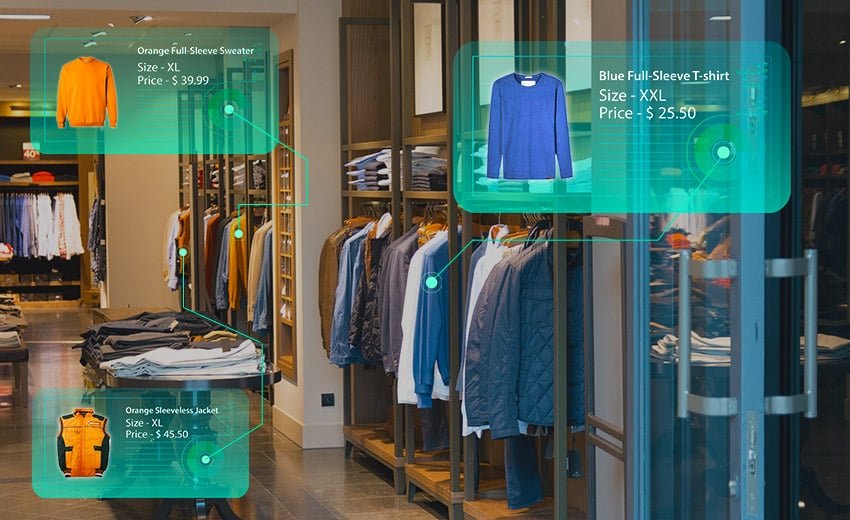Shopping in smart cities will be a better, efficient, and convenient experience for buyers as well as sellers. A lot of operations in stores and malls require continuous monitoring & manual efforts from the staff. Therefore, they lead to substantial additional costs of operation and loss of time. Emerging technologies can help facilitate every step of consumer shopping. A handful of brands are already experimenting with intelligent shopping systems. So far, these brands are receiving wonderful responses from consumers for their innovation & value proposition. Thus, a better shopping experience means better sales, and better sales lead to healthy growth. It is no wonder that IoT in the retail industry is forecasted to size up to $94.44B by 2025.
Advantages Of Intelligent Shopping Systems
IoT devices and interactive products can lead to a variety of advantages. These smart shopping systems would create value through automation, transparency, information, and accessibility. Thus, there are different ways to implement technology for a convenient shopping experience. Moreover, diverse implementations can serve different industries. Here are some of the significant advantages of next-generation shopping systems:
- Detailed product information for quicker purchases
- Rewarding purchase experiences & customer loyalty
- Product comparisons to find the best fit
- Quick exploration for knowledge of available products
- Ease of payment with no queues
- Error-free inventory management for store
- End-to-end security of stores against theft or robbery
- Post-sales engagement with customers using smartphone apps
- Guide the customer to their next purchase through Indoor navigation
Surprisingly, these are not the only advantages that come with the technology. There are many more implementations taking place to innovate the shopping process further. One such key area of innovation is data mining and data analytics. Data science is a tool that can allow studying of previous purchases and lifestyle. Based on this, algorithms can predict an individual’s next possible choice for purchase or their maximum budget for an item. Finding the key to customer purchase behavior can be helpful to provide better suggestions and advertisements as part of an intelligent shopping system.
A Set Of Tools For Smart Shopping Experience
There are certain ways where sensors, embedded devices, cameras, communication, or interfaces can be helpful for a shopping experience. Here are some of the ideas that can enhance the shopping experience:
- Connected Products & Smart Packaging:
Smart packaging refers to products with packaging that have a way to connect to the internet. These products may leverage printed codes, NFC, or AI to share more product information with users. For instance, scanning barcodes on a dairy product can share the expiry date.
- In-Store/Indoor Navigation:
UWB, Bluetooth, and RFID can help users navigate through the store. It would allow users to reach the products they need. Such indoor mapping systems can also highlight some specific areas that might interest the customers.
- Energy Management:
Stores waste enormous amounts of power even when customers are absent. It happens solely due to the lack of management of appliances. Energy management systems can help manage & save significant power. While they also provide all benefits of remote power consumption monitoring for intelligent shopping systems.
- Computer Vision & Behavioural Analytics:
Computer vision has grown beyond surveillance and monitoring. With AI & Edge computing, cameras can identify the customer’s mood while trying a product. Brands can also monitor the staff behavior with AI. Furthermore, AI cameras can enhance security by detecting infrastructure damage, misplacement, or breakouts.
- Smart Trolley Or Smart Shopping Carts:
Smart trolleys are the most exciting addition to the fresh shopping experience. These carts can guide customers with routes to purchase their items. Also, customers can see the total purchase amount, additional suggestions, measure weights, and allow a self-checkout.
- Robust Theft Prevention With Geo-Fencing:
Geo-fencing can help determine if any product is exiting the store premises without processing the payment. Any such theft in smart shopping systems directly alarms the security authorities to prevent any theft and regain the product.
Summary
To Conclude, smart shopping is also about engaging with customer post-sales through mobile apps, reward points, and gift vouchers. Clearly, there are many ideas that are being implemented with the help of intelligent shopping systems. However, these are not all of it. Affordable technology such as printed codes, NFC, RFID, and one-time investments such as smart carts & cameras make smart shopping a viable idea. Implementation of these technologies conveys that the particular brand values customer experience. Therefore, such value creation can gain significant customer loyalty and gain quick attention from the masses.
Develop great IoT solutions with high quality software, devices and infrastructures. Contact us!


